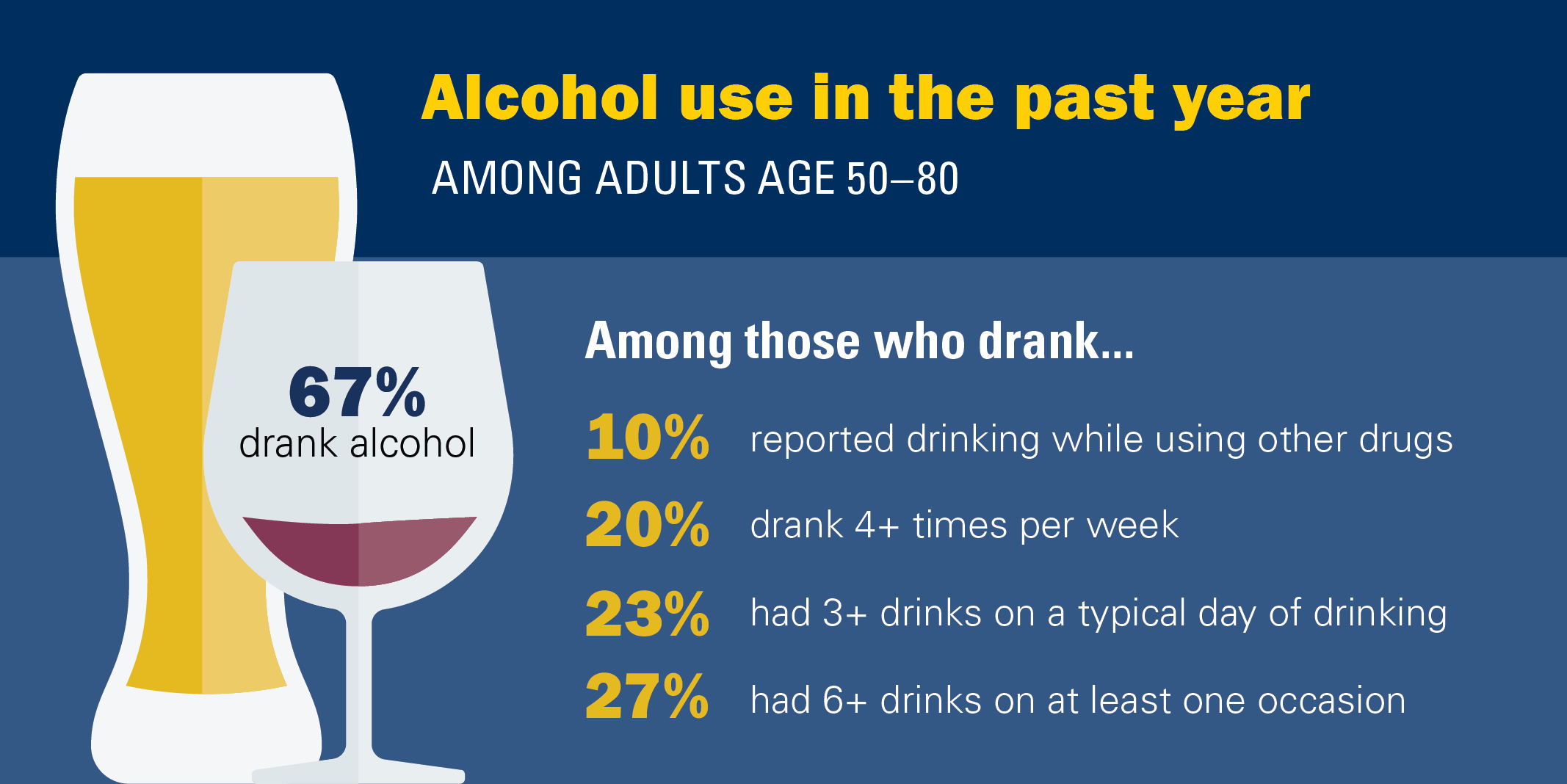
While drinking alcohol is a source of enjoyment for many older adults, it can also pose health risks. These risks include memory loss, injuries, and potentially harmful interactions with commonly prescribed medications, even at low levels of alcohol consumption. In January 2021, the University of Michigan National Poll on Healthy Aging asked a national sample of adults age 50–80 about their alcohol use and reasons for drinking.
Alcohol use among older adults
Two in three adults age 50–80 (67%) reported drinking alcohol at least occasionally in the past year. Among those who drank, 42% drank monthly or less often, 19% two to four times per month, 18% two to three times per week, and 20% four or more times per week. On a typical day of drinking, the majority (77%) consumed one to two drinks, 17% had three to four drinks, and 6% had five or more drinks.
Among older adults who reported drinking any alcohol in the past year, the most commonly reported reasons for drinking included liking the taste (50%), to be social (49%), to relax (38%), or because it was part of their routine (13%). Other reasons were to cope with stress (10%), to help with mood (9%), out of boredom (8%), or to help with pain (5%).
Men were more likely than women to report any drinking in the past year (73% vs. 61%). Men were also more likely to report a higher daily quantity of alcohol use. One in five men age 50–80 (20%) reported having three to four drinks containing alcohol on a typical day of drinking compared to 15% of women, and men were twice as likely to report five or more drinks on a typical day of drinking (8% vs. 4%).
Among adults age 50–80 who drank alcohol, one in four (27%) reported having six or more drinks on at least one occasion in the past year, and 7% said that alcohol had ever made it difficult for them to remember parts of the day or night (i.e., alcohol use led to a “blackout”).
Use of alcohol with other drugs
One in ten adults age 50–80 (10%) who drank alcohol in the past year said they drank while using other drugs, including marijuana, prescription tranquilizers, prescription sleeping pills, prescription pain pills, and/or any illicit drugs. Alcohol-related blackouts were more common among those who consumed alcohol while using other drugs (20%) compared to those who did not (6%).

Treatment for alcohol use
One in four older adults (27%) said there was a time in their life when they thought they were drinking too much, and 10% of adults who drank alcohol reported there was a time in the past year when they thought they were drinking too much. One in five of those who thought they had ever been drinking too much (19%) had ever sought help from a therapist, doctor, or support group, and one in ten (9%) sought help during the past year.
Use of alcohol during the COVID-19 pandemic
During the COVID-19 pandemic, 27% of older adults reported a decrease in their alcohol use, 14% an increase, and 59% had no change in their alcohol use. Among those who reported drinking for social reasons, 11% increased their drinking during the pandemic. Among those who reported drinking to relax, 26% increased their alcohol use during the pandemic. The proportion who reported an increase in their alcohol use during the pandemic was higher for those who said they drank to help with pain (49%), to cope with stress (48%), out of boredom (46%), to help with mood (38%), or as part of their routine (31%).
There was also an association between feelings of loneliness and changes in alcohol use during the pandemic. Older adults who reported a lack of companionship some of the time or often in the past year were more likely to say they increased their alcohol use during the pandemic than those who hardly ever lacked companionship (19% vs. 12%). Similarly, those who reported feeling isolated some of the time or often in the past year were more likely to have increased drinking during the pandemic than those who hardly ever felt isolated (19% vs. 10%).
Implications
This poll showed that the majority of older adults do not drink alcohol or drink at low to moderate levels defined by federal guidelines for adults of legal drinking age as two drinks or less in a day for men and one drink or less in a day for women. However, some adults age 50–80 reported more risky alcohol use. For example, 23% reported drinking three or more drinks on a typical day of drinking, and one in ten older adults who drink have combined alcohol with other drugs. Exceeding guidelines for moderate drinking and combining alcohol with other drugs increases older adults’ risk of adverse health and social consequences. Some older adults, depending on their health conditions and medications, may experience health consequences at lower levels of alcohol use. Yet, few older adults reported having concerns about their current alcohol use or have sought help for alcohol problems.
Aging affects how the body responds to alcohol and other substances and specifically increases the brain’s sensitivity to the effects of alcohol and drugs. This can mean that drinking at levels older adults did when they were younger can now pose more substantial health risks. Older adults who choose to drink should speak with their health care providers about safe levels of alcohol use and discuss the possible adverse effects from combining alcohol and medications. Combining alcohol with certain medications such as opioids can be particularly dangerous.
Health professionals who care for older adults should routinely ask about alcohol use using short evidence-based questionnaires. Brief interventions can be used during medical visits to address concerns with alcohol use. These interventions should emphasize education on how the health risks of alcohol use change as people age. Health professionals should also routinely ask older adults about whether they use any other drugs when drinking alcohol and counsel them about the risks of combining alcohol with other drugs.
For older adults who would like help with cutting down on their alcohol use, or stopping drinking altogether, proven strategies and treatments can help them achieve these goals. Some older adults could benefit from referrals to alcohol treatment programs but may require support to access these services.
Families can also play an important role in addressing alcohol use among older adults. Loved ones should be aware that alcohol use may be associated with an increased risk of health and other problems and can encourage older adults to seek help, if needed.
For those who choose to drink alcohol, ensuring that alcohol consumption stays within safe levels can contribute to overall health and well-being.
Data Source and Methods
This National Poll on Healthy Aging report presents findings from a nationally representative household survey conducted exclusively by Ipsos Public Affairs, LLC (“Ipsos”) for the University of Michigan’s Institute for Healthcare Policy and Innovation. National Poll on Healthy Aging surveys are conducted by recruiting from Ipsos KnowledgePanel®, the largest national, probability-based panel in the U.S.
This survey module was administered online in January 2021 to a randomly selected, stratified group of older adults age 50–80 (n=2,023). The sample was subsequently weighted to reflect population figures from the U.S. Census Bureau.
The completion rate was 78% among panel members contacted to participate. The margin of error is ±1 to 3 percentage points for questions asked of the full sample and higher among subgroups.
Findings from the National Poll on Healthy Aging do not represent the opinions of the University of Michigan. The University of Michigan reserves all rights over this material.
Read other National Poll on Healthy Aging reports and about the poll's Michigan findings, and learn about the poll methodology.
Citation
Fernandez A, Kullgren J, Malani P, Singer D, Kirch M, Solway E. Alcohol Use Among Older Adults. University of Michigan National Poll on Healthy Aging. June/July 2021. Available at: http://dx.doi.org/10.7302/1328